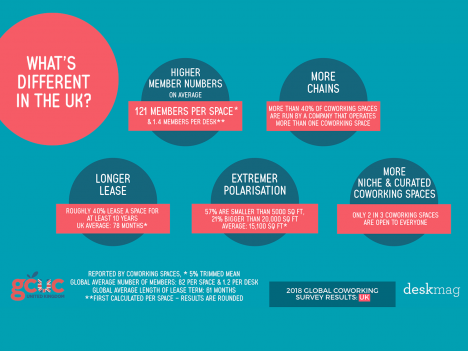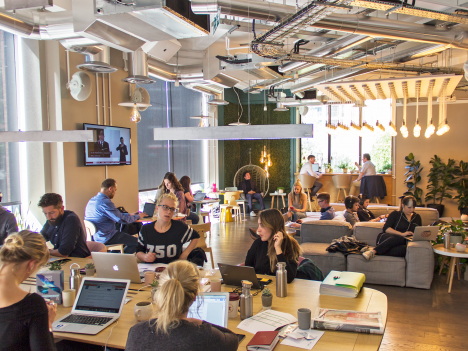Will the UK coworking bubble burst? According to operators, the answer is a clear ‘no’. Only 1 in 5 reported that there are “too many coworking spaces” in the UK, slightly higher than the global average. However, this differs in large cities, especially in London where the majority of coworking operators believe the opposite.
:::
The independent analysis of the 2018 Global Coworking Survey was supported by Essensys, Nexudus & WUN Systems. A summary of the UK's results was presented at GCUC UK.
:::
On average*, coworking spaces in the UK host 121 members, up from 102 last year (+19%), and significantly more than in 2016 (+81%). Unsurprisingly, the number of desks and size have also increased. Coworking spaces now have an average of 109 desks (+87%) and 15100 square feet (+81%), both notably higher than the previous year.
A polarised market
However, the coworking market in the UK is polarised. Average results should therefore rather be seen as an intersection rather than a representation of the overall situation. Large coworking spaces especially distort the average. In reality, more than half of UK coworking spaces provide less than 50 desks and 5000 square feet. Nonetheless, although the UK’s member number per desk of 1.39 (2017: 1.47) is slightly shrinking, it is still ranked above the global average. This result was calculated first per coworking space, before measuring the average for all coworking spaces.
Three other notable differences
The UK also differs from the European and global average in three other criteria: 1) The average lease is longer among coworking spaces. More than 40% of offices lease their location for at least 10 years. This result is also notably impacted by large locations. 2) 42% of coworking spaces are run by a company that operates at least two locations. This group mostly overlaps with those who have longer leases. 3) Every third coworking space in Britain is curated or serves a niche group.
But are there similarities too?
The UK’s coworking spaces also share some similarities with the global coworking movement. ‘Only’ 39% of spaces are profitable, which is close to the global level of 42%. Does this sound low? Not really, considering the constant high share of recently opened coworking spaces. 27% of spaces in the UK are less than a year old. Moreover, coworking spaces are often just part of a broader business model. The majority of operators have at least one other job. You can read more about the profitability of coworking spaces here and here.
Understanding the statistics of open workspaces
Surprisingly, open workspaces maintain a high share of the total area within a coworking space. Although bigger coworking spaces tend to implement a higher share of private offices, open-plan workspaces still account for half of the UK’s coworking spaces, if coffee and lounge areas are included. It is important to note that larger coworking spaces cannot distort statistics regarding the layout the same way as they can affect unrestricted variables such as the number of members, desk, size, or length of lease. Why? The reason is simple. Coworking spaces can’t have 600% or 5000% of private offices within one location. The figure is restricted to a maximum of 100%. In restricted or percentage scales, smaller coworking spaces can have a bigger impact on statistics, especially if they are in the majority. This also explains why large locations influence the share of profitable coworking spaces slightly more.
The target coworking market in the UK
The vast majority of the UK’s coworking spaces still strongly focus on classic target groups. Around 80% target individuals and 2 in 3 target micro companies with less than 10 employees. The share of spaces that heavily focus on micro companies is slightly higher than the global average. However, the number of coworking spaces targeting larger companies is significantly lower. Only 1 in 10 coworking space shows a strong interest in companies with 10 to 99 employees, and 1 in 20 in companies with 100 and more employees. The interest in larger companies is higher when considering coworking spaces that are impartial towards the two latter groups.
:::
You can view the general statistics by clicking on the article image. All general global results are available via this link for free. The ‘Ultimate Coworking Space Data Report’ provides a more widespread collection of global results.
:::
The 2018 Global Coworking Survey is officially supported by the following organizations:
Main Supporters:
Essensys - A management tool for coworking spaces
Nexudus Spaces - A management tool for coworking spaces
WUN Systems- A management tool for coworking spaces
Distribution partners:
Coworker.com - A platform to find and book coworking spaces
Social Workplaces - An event organizer and consulting agency for coworking spaces
Here, you can read more about the 2018 Global Coworking Survey.
* Unless stated otherwise, we express average values in 5% trimmed mean for unrestricted scales (e.g. number of staff members). This means that the lowest and highest 5% of all values are not taken into account. The result is that we can filter the extreme outliers from the average.











